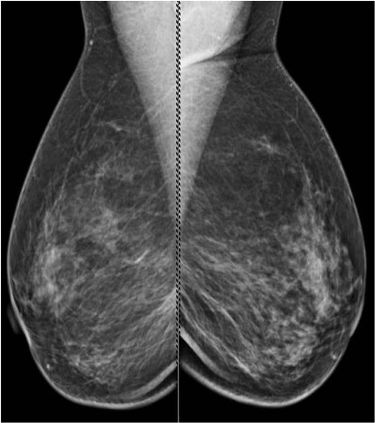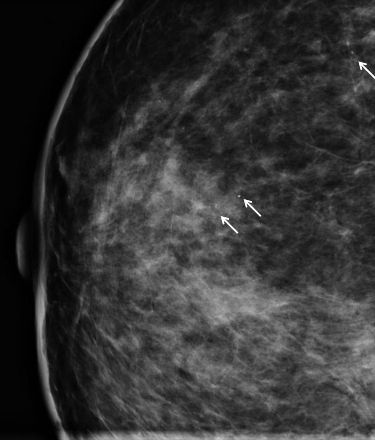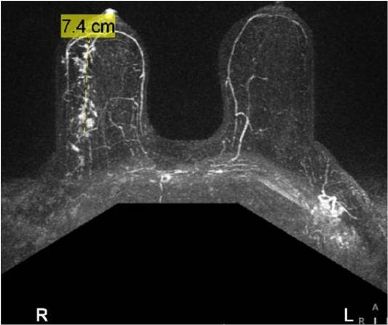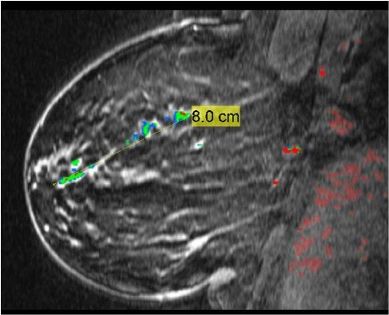Ductal Carcinoma in Situ
A 57-year-old patient presents for evaluation of right nipple discomfort. The patient has family history of a mother and sister with premenopausal breast cancer.
CLINICAL HISTORY
A 57-year-old patient presents for evaluation of right nipple discomfort. The patient has family history of a mother and sister with premenopausal breast cancer.
FINDINGS
Digital mammography shows area of calcifications (Figure 1a-b). Magnification views demonstrate intraductal pleomorphic microcalcifications in the right 11:00 area (Figure 1c).
No noted findings on physical exam or ultrasound.

(Figure 1a)

(Figure 1b)

(Figure 1c)
MRI imaging performed for extent of disease demonstrates linear beaded enhancement extending from nipple posteriorly for 8cm within the right breast upper outer quadrant (Figure 2a-b).

(Figure 2a)

(FIgure 2b)
DIAGNOSIS
Vacuum assisted stereotactic needle core biopsy of the right breast 11:00 microcalcifications reveals ductal carcinoma in situ.
DISCUSSION
This case demonstrates the benefit of multimodality imaging including digital mammography and breast magnetic resonance imaging (MRI) in this patient, which led to a diagnosis of ductal carcinoma in situ (DCIS). There has been some conflicting information in the literature regarding MRI and its usefulness in the evaluation of DCIS. For this patient, the MRI revealed the extensive area of involvement more so than mammography. This information was critical to the surgeon for surgical planning.
Stamatia Destounis, MD, is managing partner and a radiologist at Elizabeth Wende Breast Care in Rochester, NY.
Can CT-Based AI Radiomics Enhance Prediction of Recurrence-Free Survival for Non-Metastatic ccRCC?
April 14th 2025In comparison to a model based on clinicopathological risk factors, a CT radiomics-based machine learning model offered greater than a 10 percent higher AUC for predicting five-year recurrence-free survival in patients with non-metastatic clear cell renal cell carcinoma (ccRCC).
The Reading Room Podcast: Current Perspectives on the Updated Appropriate Use Criteria for Brain PET
March 18th 2025In a new podcast, Satoshi Minoshima, M.D., Ph.D., and James Williams, Ph.D., share their insights on the recently updated appropriate use criteria for amyloid PET and tau PET in patients with mild cognitive impairment.
Could Lymph Node Distribution Patterns on CT Improve Staging for Colon Cancer?
April 11th 2025For patients with microsatellite instability-high colon cancer, distribution-based clinical lymph node staging (dCN) with computed tomography (CT) offered nearly double the accuracy rate of clinical lymph node staging in a recent study.
Could Ultrafast MRI Enhance Detection of Malignant Foci for Breast Cancer?
April 10th 2025In a new study involving over 120 women, nearly two-thirds of whom had a family history of breast cancer, ultrafast MRI findings revealed a 5 percent increase in malignancy risk for each second increase in the difference between lesion and background parenchymal enhancement (BPE) time to enhancement (TTE).
Study Suggests AI Software May Offer Standalone Value for X-Ray Detection of Pediatric Fractures
April 9th 2025Artificial intelligence (AI) software demonstrated a 92 percent sensitivity for detecting fractures in a study involving over 1,600 X-rays from a tertiary pediatric emergency department.